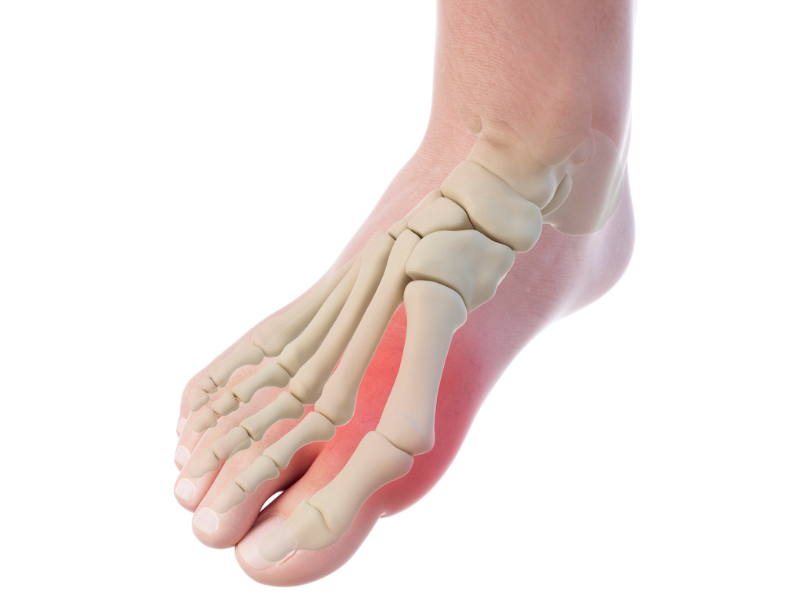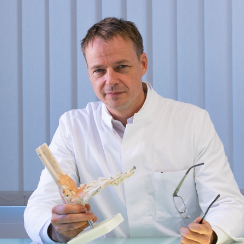For some years now, bunion toes - also called hallux valgus - have increasingly been operated on minimally invasively. This is a technique known as MIS - Minimally Invasive Surgery. As an experienced foot surgeon who specialises exclusively in feet and treats them holistically, I am often asked by patients what it means to operate on a hallux valgus in a minimally invasive way? I will inform you about this in this blog article.
How does minimally invasive surgery or MIS work for a hallux valgus deformity?
With tiny incisions and a small wound, the malposition, i.e. the bunion, is corrected. This means that the big toe is straightened and the forefoot is narrowed by removing the bunion. After the operation, the corrected malposition can be fixed with titanium screws. These are also placed through minimal incisions in the tissue. The patient is allowed to put full weight on the foot immediately after the operation, i.e. while the bone is healing, without crutches. During the first weeks, the foot is protected with a bandage and an orthosis.
What is the difference between a minimally invasive and an open hallux valgus surgical procedure?
In contrast to the minimally invasive surgical procedure, in an open or causative procedure the foot is opened in the affected areas and then surgery is performed on an open wound, through a correspondingly larger incision. The malposition is corrected by setting the bones correctly and removing parts of the bone and bunion. The repositioned bones are fixed with screws. Depending on the severity, the foot can be loaded after the operation or crutches are used initially.
What are the advantages of minimally invasive hallux valgus surgery?
This technique is generally used for patients with a small or moderate hallux valgus deformity. The minimally invasive hallux valgus correction offers several advantages:
- The operation time is usually somewhat shorter. This means that the classic surgical risks for patients are somewhat reduced as a result.
- The healing time after a minimally invasive procedure is a few weeks less. You can therefore return to work and sports activities more quickly.
- Because the wound is smaller, there is usually less tissue damage during the operation.
- The joint capsule of the metatarsophalangeal joint of the big toe is not affected by the procedure, so movement restrictions in the forefoot are less frequent.
With this hallux valgus surgical procedure, the patient can "get back on his feet" more quickly overall, not least because the operated foot can be loaded again immediately after the operation. Psychologically, this is also helpful because it makes the patient feel better.
What can be the disadvantages of minimally invasive hallux valgus surgery?
Our feet carry the weight of the whole body. The stability of our feet is therefore enormously important. After foot surgery, the bones must be able to withstand future loads again in the long term. After a minimally invasive correction, these disadvantages can arise:
- The reduced visibility during surgery is compensated by the use of X-rays. This means a higher radiation dose for the patient.
- Due to the small access (minimally invasive), the foot surgeon also has only a limited view, so that intensive attention must be paid to nerves, vessels and tendons so that they are not injured. The foot surgeon should therefore be very experienced.
- Patients are allowed to put weight on the foot immediately after minimally invasive hallux valgus surgery, i.e. bone healing takes place while the patient puts weight on the foot or bone. It is important that the treating foot surgeon checks the foot regularly so that the bone healing takes place in the correctly placed position and good foot stability can be established.
The opinion of Tonio Gottlieb, MD:
"The minimally invasive surgical procedure is usually used for minor to moderate deformities of the hallux valgus. Ultimately, however, a decision about the surgical procedure should always be made on a case-by-case basis, because only after a comprehensive history, examination and diagnosis can the treating foot orthopaedist or foot surgeon make a stringent treatment recommendation to the patient."
Why is the second opinion important before a hallux valgus operation?
Regardless of whether minimally invasive or open hallux valgus surgery is planned, a second opinion should be sought. The most important goal for the patient is that the bunion does not become crooked and lopsided again after surgery and the foot becomes misaligned again. Otherwise, this means a recurrence of pain, a lack of foot stability and a renewed deformity of the foot.
The experience of foot surgeon Tonio Gottlieb, MD:
"I frequently treat hallux valgus patients who come to me for a follow-up correction because they still have pain after the surgical intervention or because they have foot pain again after some time or because the big toe is again in a crooked position. Therefore, please inform yourself carefully and obtain a second opinion before agreeing to a surgical intervention for a planned hallux valgus correction - regardless of whether you prefer a minimally invasive or a cause-oriented correction. A post-correction is always a painful experience for patients, because with the new operation, a corresponding healing process and follow-up treatments are also required again.“
How can the foot be strengthened after minimally invasive hallux valgus surgery?
Good foot stability gives you back a high degree of quality of life. That is why a hallux valgus correction is always worthwhile, regardless of whether it is initially done conservatively, e.g. with a splint, or surgically. As a rule, you will then be able to resume sporting activities such as hiking and jogging or simply longer walks or your favourite sport as a matter of course. With regular foot exercises, you can do something for the stability, mobility and strengthening of your feet yourself. We have put together a few foot exercises for you here.
The recommendation of Tonio Gottlieb, MD:
„Go to an experienced food specialist and foot surgeon who treats feet holistically and has many years of hallux valgus surgery experience. Then you are in good hands when it comes to permanently correcting a crooked position of the big toe or another foot malposition.”
For more information on hallux valgus surgery, click here:



